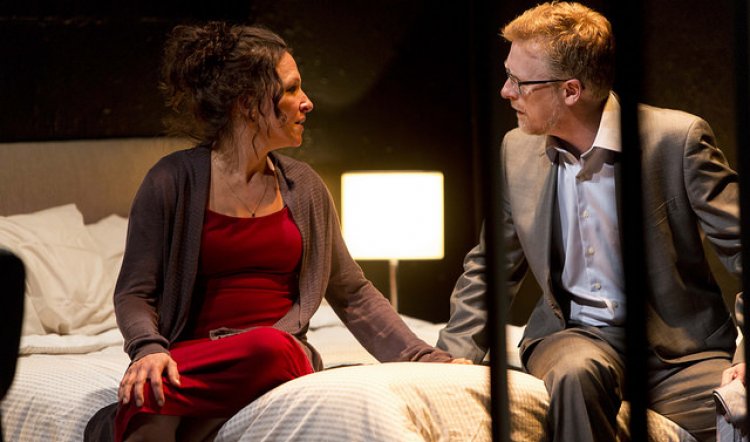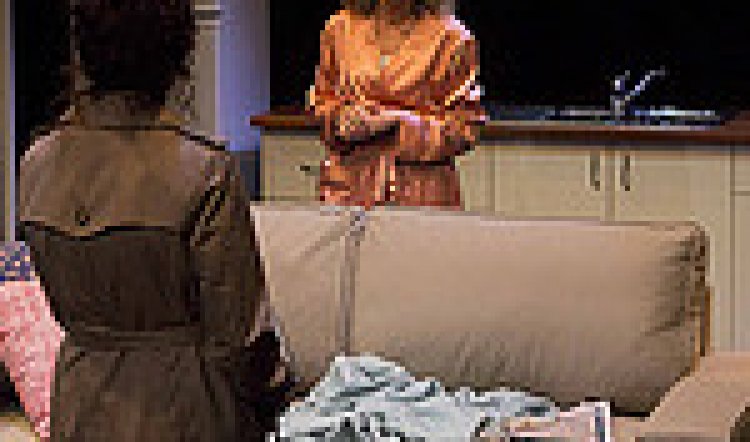
NORA
NORA, Upstairs Belvoir at Belvoir, 9 August-14 September 2014. Photography by Brett Boardman: above - Blazey Best and Damien Ryan; right Blazey Best and Linda Cropper.
Anne-Louise Sarks is Belvoir’s newest Resident Director and this production goes in the “much anticipated” basket after 2012’s Medea, her award-winning and wonderful collaboration with Kate Mulvany. Unfortunately, this latest “re-thought classic” is not in the same league and probably belongs in the “be careful what you wish for” basket.
Sarks and playwright Kit Brookman have updated, extended and generally beaten up Henrik Ibsen’s great play of 1879 until it is barely recognisable. This is not necessarily a bad thing, indeed the main idea is intriguing: what happened to Nora after she walked out on her marriage and slammed the front door. That slam reverberated across the world and continues to do so, so it’s natural that many would wonder - what did she do next? What became of her?
In a neat twist on the original, instead of Nora’s widowed friend Helen (Linda Cropper) turning up on her doorstep seeking shelter, it is Nora who knocks on Helen’s door. But in yet another example of failure to ask the vital question “and then what?” once the bright idea was had (see Dark Voyager - right and Macbeth at limelightmagazine.com.au), it seems little attention was paid to whether this germ of an idea had the legs to carry it full term.
The first half is a bit of a canter through the Ibsen original - Nora wanders about her house being utterly miserable while husband Torvald (Damien Ryan) is being blithely oblivious and husbandly. Nora’s young daughter is perturbed that mummy is spending a lot of time crying, but Nora merrily brushes off her fears - everything is fine. The kids play and Torvald tells Nora all about what’s happening at the bank, which is very exciting and involves someone getting the sack. Nora tells him about her day which is as mundane as mild tooth ache - no wonder she is bored to sobs and inwardly aching with frustration.
As happens in the original, an end of sorts arrives when Nora tells Torvald she is leaving - and does so. It’s the interval and the audience is also asked to leave the auditorium and we must “await further instructions”. Hang on though, Nora’s left, it’s also the end of the play. But no - there’s more. Well, less in some senses. While we’ve been hanging about downstairs the rather clever set - of a minimally sketched, metal frame setting of the Helmer family home (Marg Horwill design and Paul Jackson lighting) has been reduced by several rooms to become Helen’s small apartment.
In the context of A Doll’s House there was some sense in the meeting of the two unlikely friends, but that’s missing here in the idea of two women who’ve not actually seen each other for years and even then were fairly distant work colleagues. Nevertheless, Nora tells Helen that after leaving the marital home with no plan or goal she soon decided to walk across town to knock on Helen’s door and cadge a bed for the night. But never mind the logic - feel the dialogue.

The thing about Ibsen’s play about mundane domesticity is that the writing sparks and fizzes and catches fire. Unfortunately in this reworking and imagined what-came-next the writing is even more mundane than the situation and spark and flame are notably absent. Basically, Helen makes Nora a cup of tea which involves filling a real kettle with real water and waiting for it to boil in real time. Then Nora and Helen drink gin, convert a sofa-bed into a bed and make it up with a bottom sheet - smoothed and tucked in; a top sheet - smoothed and tucked in; then pillow slips are put on pillows (Helen does it neatly, Nora does it clumsily) and finally a blanket is added, again neatly tucked in and again in real time. It’s a scene painfully reminiscent of a ’70s feminist movie, the infamous Tillie Olsen’s I Stand Here Ironing in which the heroine did just that, for hours.
If that were not enough, the lengthy dialogue between the women which makes up the second half is desperately dreary and static. It goes nowhere, but unlike a Waiting For Godot-nowhere, this is just…nowhere. And it is painful to watch two of our finest actresses struggle to inject meaning and life into the meaningless and deathly prose they’ve been given to work with. (Honest admission: having swallowed painkillers during the interval for excruciating back pain, I momentarily dozed off at some point and may have missed something vital and thrilling, but I’m not convinced.)
Meanwhile, there is an unintentional and rather distracting frisson in the casting of Damien Ryan as pompous old Torvald. He is, of course, boss of Sport For Jove, the company which has just experienced a much deserved popular, critical and box office hit with Adam Cook’s superbly realised and directed production of A Doll’s House (aka the real thing). It’s vividly fresh in the memory and sadly, that memory overwhelms this interminable dullness. On opening night, however, the various claques were in high applause mode, so it would be (mildly) interesting to see a performance with normal people in the auditorium.
A dreadful waste of some marvellous talent. It's also a stark reminder that there's only one Mulvany like a Kate Mulvany. And whomever acquired the wig that’s unforgivably plonked on Linda Cropper’s head should take it back to the taxidermist where it can resume its place in the display “Dead Racoon - Roadkill”.



